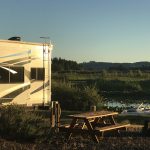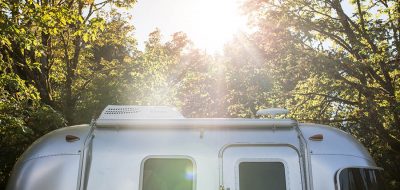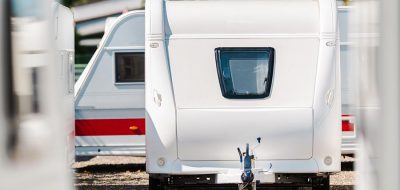I’ve got a real mixed bag for you this month! Keeping ants out of your RV and some tech Q and A. Remember to email your RV questions to me at [email protected].
Mark:
How do you keep ants from infesting an RV when left on a gravel drive in Texas for four days while visiting relatives? Thank you, Jean
Hi, Jean:
I have found out painfully that the only way to deal with ants is to practice prevention. That means creating a barrier to stop the ants at every point where our RV’s wheels, jacks, hoses, and cords touch the ground. Use a commercial ant and roach spray to lightly spray hoses, cords, and stabilizer jack pads. Spray around the tires where they contact the ground as well. For towable RVs, I’ve found that spraying the hubs of the wheels is easier than spraying around the base of the tires, and it still works even after you have moved. Direct the spray onto the brake drums through the slots in the rims as shown in the photo below.
I’ve also learned to avoid parking where branches from trees are touching the sides and roof of the rig, and I even got burned once by leaning my walking stick up against the side of the rig. Those roving ant scouts are QUICK, sometimes only needing a few hours to find your kitchen. Speaking of kitchens, be sure to keep everything cleaned up inside. Remove trash regularly, and keep dishes washed and countertops and stovetops clean. It really helps a lot if there’s no food source to attract them. Finally, if the dreaded infestation does develop, see if you can spot the entry point by looking for the tell-tale ant trail, and then spray that area to create or re-establish the barrier. If the ants seem to be camping permanently in your rig, try commercial ant baits, or pick up a bottle of Terro ant killer from your local hardware store and use as directed. I have found that Terro is very effective on those little sweet-eating ants that are common in the South. www.terro.com
Hi, Mark:
Several times, I have camped where the 30-amp service was apparently not up to snuff. The outside (service pole) 30-amp breaker tripped without the inside (trailer) 30-amp breaker having tripped. Other times, the inside breaker tripped when the draw apparently exceeded the trailer’s 30-amp breaker limit. This was usually due to the AC going and someone turning on too many appliances. What do you think about replacing the service cable with a 50-amp cable and replacing the main breaker with a 50-amp breaker? Also required would be replacement of the wiring from the service cable to the breaker panel. The individual breakers will still protect their associated wiring. Using the larger-gauge service cable will eliminate (or lessen) the loss (voltage drop) experienced with typical 25-30 foot-length cables. I don’t see any drawbacks or safety implications to this change. What do you think? Larry
Hi, Larry:
RV park pedestal breakers take a lot of abuse, so it’s not uncommon to find defective ones. Circuit breakers do, indeed, become weak, especially if they have been overheated or tripped a large number of times. Since these breakers operate thermally, you may find that they are weaker on a hot day than on a cold one. While it is possible to modify the existing AC distribution system in your RV, it is a task that should only be attempted by persons with appropriate skills and knowledge. For that reason, I would be hesitant to recommend it. A lot depends on the ratings of the existing breaker panel in your RV. It may not be designed for, or adequate for, the higher working amperage. However, I may be able to offer a real-world solution that does not require modification of the electrical system. Simply purchase a standard RV 50A to 30A adapter cord, commonly referred to as a “Dog Bone,” and use it when the 30A breaker is weak and a 50A receptacle is available. While it’s not a perfect solution, it is a safe and easy one to implement. The 30A breaker in your rig becomes the primary protector of the umbilical cord rather than the 50A breaker at the pedestal. That’s not really a technically correct setup from an electrical code standpoint, but it works fine in practice, as many RVers have discovered.
Hi, Mark,
I have a coachman 23 foot Rv for the past 13 years and have been the camp host in Juneau Alaska. There is no RV help in our area and I wonder what this means: My furnace when turned on squeals really loud. I am afraid to turn it on. Where do I get it fixed?? Joy
Hi, Joy,
It sounds like your furnace fan motor has a bad bearing. They do wear out, especially if you use the furnace a lot, which I suspect you do! That squealing noise is caused by the bearing failing, and it will eventually seize up if you continue to run it. It is possible to replace just the fan motor or assembly, but after 13 years, you might be better off replacing the entire furnace. Most RV appliances are designed for occasional use, like for vacationing or camping. Living full-time in an RV really puts a lot more wear and tear on the appliances and fixtures. Since you are in Alaska, I’m not sure whether it would be better to try to track down a new furnace locally, or order a replacement from the lower 48 and have it shipped to you. Get the model number and manufacturer information off your old furnace (it should be on a label on the access panel or somewhere on the exterior cabinet) and check with some online RV parts suppliers. I recommend PPL Motorhomes, here in Houston, TX, as they have an outstanding parts department, and ship all over the country. http://www.pplmotorhomes.com/parts/rv-furnaces-suburban-atwood-parts-1.htm
They have a knowledgeable staff, and you can call them for assistance if you are not sure what you need.
Mark, when storing an RV for the winter or a short period of time, what is the best position to store the slide-outs, in or out? – roomaster85
Hi, roomaster,
Slideouts are designed to allow the RV to travel down the road in all sorts of weather. To prevent water from getting in while driving in a storm, slideouts must form a good weather seal when retracted. When a slideout is extended, the sealing system is much less stout and is designed mainly to prevent water entry in normal rain and wind. Since slideouts seal better when retracted, I feel it is best to store your rig with the slides in the retracted position. The better seal may also help prevent pests like mice and snakes from gaining entry to your RV.
 Founded in 1978, the Escapees RV Club provides a total support network that includes a wide variety of services and opportunities:
Founded in 1978, the Escapees RV Club provides a total support network that includes a wide variety of services and opportunities:
- Mail Service- Escapees offers the largest private mail service in the country. Members are able to personalize their mail delivery with multiple options. Custom sorting options, delivery schedule and even mail scanning. We make it easy!
- Mapping Tool- Plug in your starting point and destination, and let us do the rest! Our mapping tool will show you discount parks along your route, as well as trusted commercial members and endorsed vendors to help you with all of your needs along the way.
- Education- From our annual Escapades to our discussion forum, we help you connect with fellow RVers to share experience and knowledge. For the hands-on learner, RVers’ Boot Camp is a great way to learn about RV operation, safety and maintenance. Our award-winning magazine is also a great resource for peer-to-peer advice from fellow RVers and industry experts.
- Community- When you see an Escapees sticker on a rig, you know you’ve found a friend. Escapees hosts a variety of events throughout the year, including convergences, excursions, chapter rallies and Escapade. Each of these offers the opportunity to connect with other RVers and make new friends.
A complete listing of all Escapees events and a comprehensive list of member benefits are found at www.escapees.com










Anonymous
Thank you for all of your information it is very helpful. I agree with ppl motorhomes are also very helpful. Jim